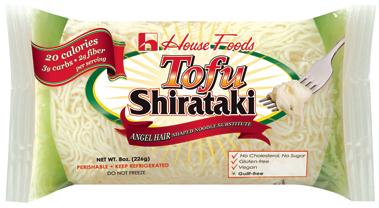 What? Pasta noodles that are low carb, low calories, high fiber, sugar free, dairy free and gluten free? Yes, we are talking about Tofu Shirataki noodles. It has along been a favorite noodles in Japanese diet. The many health benefits have made it grown in popularity among diabetics, dieters, gluten free consumers in the U.S. Take a look at nutrition facts comparisons.
What? Pasta noodles that are low carb, low calories, high fiber, sugar free, dairy free and gluten free? Yes, we are talking about Tofu Shirataki noodles. It has along been a favorite noodles in Japanese diet. The many health benefits have made it grown in popularity among diabetics, dieters, gluten free consumers in the U.S. Take a look at nutrition facts comparisons.
Nutrition Facts:
Serving Size 4oz (113g) prepared (2 servings/pkg)
Calories 20 100 calories / 1/2 cup of regular pasta
Total Fat 0.5 g Low fat for heart health, weight management
Saturated Fat 0 g Good for your heart
Cholesterol 0 mg Heart healthy
Sodium 15 mg A very low sodium food
Total Carbohydrate 3 g Low carb food for diabetics
Dietary Fiber 2g Good source of soluble fiber, a low glycemic index food
Protein 1g Not high in protein but a low fat protein source
1 Effective Net Carb A great food for blood sugar control
“zero” Weight Watcher points in one serving Good news for WWs
So what are these noodles?
Tofu Shirataki noodles are yam noodles with tofu. It is a great pasta alternative made from blending the root of the Konnyaku – a member of the yam family and tofu. Konnyaku potatoes are cultivated for food in Japan, but wild forms grow naturally in Southeast Asia and China. They contain fair amount of soluble fiber called glucomannan. You can find glucomannan in a supplement form use for blood sugar control, reduce high blood pressure, cholesterol lowering and as a weight loss aid.
These are thin, translucent, gelatinous noodles. They do not have much taste of their own but absorb the flavors of added sauce and anything else you add in your recipe. They are great as pasta with a sauce, stir fry, or in soups. Tofu Shirataki noodles are one of those foods you either hate or love. Many commenters on the net said they would eat any pasta like product that only has less than 50 calories per 2 serving package and being less than 1 carb as well. Tofu Shirataki noodles comes in a variety of shapes: Spaghetti, Fettuccine and Angel-Hair. Most reviewers liked the product and a few can’t seem to get used to the bouncy texture.
The plain Konjac shirataki noodles with no tofu was reported to be more chewy, rubber like texture, and is harder to find at local whole foods stores. Tofu shirataki and the plain type are both good low carb products for diabetics, and for weight control.
Preparation is easy. It comes in a bag with liquid.
* Open package into a colander, drain and rinse well with warm or hot tap water. Some reported a fishy smell when first open but goes away quickly during rinsing. I would leave it soaking in water after rinsing while doing other prep work.
* Boil for 1-3 minutes, more cooking seems to be OK. This process tends to reduce the chewy texture and making it more like regular pasta.
* Some people like to just microwave for 1-2 minutes after rinsing, then add their favorite sauce. They are best tasting in a highly seasoned dish with a lot sauce or broth.
Where to buy shirataki noodles:
Asian markets, whole food stores, and online
I bought mine at health food store for $2.20
if you buy online in bulk – 10 pack for ~$18.
Shirataki is a refrigerated product and will last about 4 to 6 months in the refrigerator. and it should not be frozen. If ordered through online stores, they will be shipped with ice.


